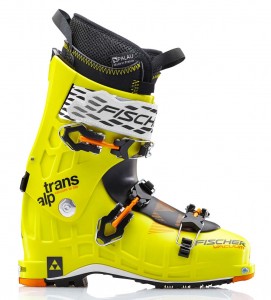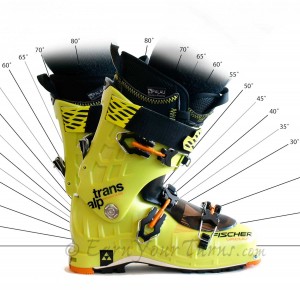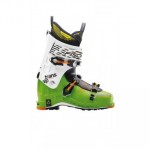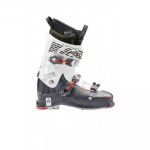TransAlp for Touring
There’s lots to like about Fischer’s Trans Alp. As you might expect, it has most of the features you would expect in a boot made with long tours in mind. For starters it comes with tech inserts for use with light weight, durable 2-pin tech bindings. The lugged soles provide good grip on slippery surfaces when you’re walking or scrambling with skis on your back, not underfoot.
It may not take the cake for being the lightest boot on the market, but at less than 3½ pounds per boot it certainly qualifies as a light, not a mid- or heavy weight boot.The cuff has great range of motion in tour mode, 18° back, 35° or more forward, with relatively little resistance to leg movement. Half that comes from the cuff allowing a lot of fore-aft movement, and half from a tongued Palau™ liner constructed to enhance movement, not restrict it. Although there is reinforcing plastic on the cuff of the liner, it isn’t thick, and is articulated to allow movement when the cuff shell is loose.
Fit Volume
Fitwise the TransAlp series tends to fit a lower volume foot than their Ranger series. In either case it is worth noting that the use of heat moldable Vacu-Plast shell material sort of renders dimensional numbers like last width moot since, at least for dealers with the Vacuum Molding System the shell can be stretched or shrunk up to 5mm in either direction. Unlike other boots with this shell molding option, like Salomon, the lower shell and cuff are both made with Vacu-plast, something those with bony ankles will appreciate. In terms of the width of the sole, the last width does define the starting point, and is a foundational dimension that can’t change, but the shell above it can be easily made wider, and to a lesser extent, shrunk, as your foot may desire. For the majority of feet, simply having a heat moldable Palau liner should accommodate fit issues for most feet.
Keep in mind molding Vacu-plast doesn’t require a Vacuum Molding System; in fact the shell material molds even easier and at lower temperatures than Pebax®, Grilamid®, or Polyurethane. However it takes longer (> 24 hrs.) to set. In the case where you need multiple punches Fischer’s vacuum molding process theoretically offers a faster, more precise solution, but conversely requires a shop with the expertise to do it well. Be aware this vacuum molding process is an art that is still evolving. As a general rule it works better for expanding than taking up volume.
Downhill Chops
All the aforementioned are solid pluses for Fischer’s TransAlp TS Lite. Where the boot comes up short is the control it offers in downhill mode. It isn’t strictly because it only offers three buckles, although that does give a quick indication of how much power it is capable of delivering. For contrast, consider Tecnica’s Cochise Pro 130; it appears to be a 3-buckle boot too, except it’s in a different league for stiffness and control. Indeed, part of the issue with the TransAlp is its overall softness, arguably around 115 for relative flex stiffness which isn’t unreasonably soft for ski touring. The real issue with the TransAlp? There simply isn’t enough cuff to be able drive a modern fat ski with power. Flex your leg forward and you will quickly realize, even with reinforcing pads on the liner cuff, the shell cuff is too short. That, unfortunately, is the fatal flaw in this boot.Conclusion
As all this suggests, Fischer’s TransAlp is a great boot for backcountry skiing where the emphasis is on taking long day tours. Woe to those who think it would be good for a traverse where you’re likely to be carrying a heavy pack, or for driving fat skis fatter than 105mm. For that you either need perfect corn conditions, a boot with a taller cuff, or impeccable technique in all conditions. Alternatively you could shed some of the fat in the planks you ride and the TransAlp would be all the boot you need.
Fischer
MSRP: $850
Weight/boot (sz. 26.5): 3 lbs., 7 oz. (1550 g)
Mens Sizes available: 23.5 – 30.5
Women’s Sizes available: 23.5 – 26.5
TransAlp TS
MSRP: $800
Weight/boot (sz. 26.5): 3 lbs., 10 oz. (1620 g)
Sizes available: 23.5 – 30.5
© 2014





6 comments
Skip to comment form
I appreciate the boot review. It seems as the number of touring boots increases it is becoming harder to find information on all of them to compare them. I was wondering if you had any insight on the Dynafit Neo. I currently have Maestrales from the 2010/2011 season and know that I will need to replace them fairly soon. I am looking for something to ski entirely in the backcountry. I currently have 188cm Coombacks and would want to be able to drive this or a similar ski. This is all complicated by the fact that I am 6’4″ and 215lbs and wear a 31.0 mondo (30.5 Scarpa). I have never felt the Maestrale was lacking for stiffness, but I do not think I would want something softer. It sounds like this Fischer is not for me. I have been trying to read reviews of the La Sportiva Spectre and Dynafit Neo because I am interested in the increased range of motion compared to the Maestrale. I was very interested in the Scarpa F1 Evo, but I am guessing it is too soft. I would be curious to hear any thoughts you might have with experience in so many different randonnee boots.
Assuming the Maestrale fits you well, then La Sportiva’s Spectre probably will too, as will Dynafits Neo. I haven’t skied the Neo, but the fit is similar, i.e. avg. to low volume. Of the 3, Neo will have a more progressive flex because of the PU shell. Spectre and Maestrale are pretty similar for downhill flex stiffness. At your weight I’d lean toward the Spectre. Review of the Spectre is on this site already. Same for Maestrale, but you already know that one first hand. Spectre may have more ROM, but Maestrale is no slouch either. Spectre is a tad smaller volume wise.
I am frustrated by buying pair of these without realizing the lower cuff concern. They felt so great on. The boot salesman was pretty clueless as to any of the cons which are shared pretty consistently throughout the transalps reviews. Is it possible for a store to take these boots back after they have been heat shrunk to your feet?
A lot of shops that include boot fitting with a boot purchase also offer a guarantee. If that were the case you could exchange them for a different model/brand of boot. Sounds like you found out about the lack of downhill performance via reviews after the fact. Alternative B: get narrower skis and take longer tours.
I know its sn old entry but I have a question. Will the lower cuff be a problem for someone who considers the Salomon Shogun a stiff and solid enough boot to drive 118-skis on the piste and in chopped up snow?
You might find the Shogun has enough cuff to drive a fat ski in cruddy conditions but I doubt you will think the TransAlp has enough muscle to equal that performance.